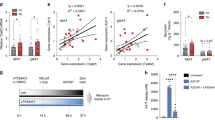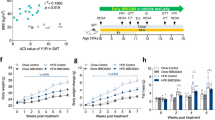Abstract
Mitochondrial uncoupling protein 1 (UCP1) is enriched within interscapular brown adipose tissue (iBAT) and beige (also known as brite) adipose tissue1,2, but its thermogenic potential is reduced with obesity and type 2 diabetes3,4,5 for reasons that are not understood. Serotonin (5-hydroxytryptamine, 5-HT) is a highly conserved biogenic amine that resides in non-neuronal and neuronal tissues that are specifically regulated via tryptophan hydroxylase 1 (Tph1) and Tph2, respectively6,7,8. Recent findings suggest that increased peripheral serotonin9 and polymorphisms in TPH1 are associated with obesity10; however, whether this is directly related to reduced BAT thermogenesis and obesity is not known. We find that Tph1-deficient mice fed a high-fat diet (HFD) are protected from obesity, insulin resistance and nonalcoholic fatty liver disease (NAFLD) while exhibiting greater energy expenditure by BAT. Small-molecule chemical inhibition of Tph1 in HFD-fed mice mimics the benefits ascribed to Tph1 genetic deletion, effects that depend on UCP1-mediated thermogenesis. The inhibitory effects of serotonin on energy expenditure are cell autonomous, as serotonin blunts β-adrenergic induction of the thermogenic program in brown and beige adipocytes in vitro. As obesity increases peripheral serotonin, the inhibition of serotonin signaling or its synthesis in adipose tissue may be an effective treatment for obesity and its comorbidities.
This is a preview of subscription content, access via your institution
Access options
Subscribe to this journal
Receive 12 print issues and online access
$209.00 per year
only $17.42 per issue
Buy this article
- Purchase on Springer Link
- Instant access to full article PDF
Prices may be subject to local taxes which are calculated during checkout




Similar content being viewed by others
References
Qiu, Y. et al. Eosinophils and type 2 cytokine signaling in macrophages orchestrate development of functional beige fat. Cell 157, 1292–1308 (2014).
Shabalina, I.G. et al. UCP1 in brite/beige adipose tissue mitochondria is functionally thermogenic. Cell Reports 5, 1196–1203 (2013).
Cypess, A.M. et al. Identification and importance of brown adipose tissue in adult humans. N. Engl. J. Med. 360, 1509–1517 (2009).
Ouellet, V. et al. Outdoor temperature, age, sex, body mass index, and diabetic status determine the prevalence, mass, and glucose-uptake activity of 18F-FDG-detected BAT in humans. J. Clin. Endocrinol. Metab. 96, 192–199 (2011).
Saito, M. et al. High incidence of metabolically active brown adipose tissue in healthy adult humans: effects of cold exposure and adiposity. Diabetes 58, 1526–1531 (2009).
Berger, M., Gray, J.A. & Roth, B.L. The expanded biology of serotonin. Annu. Rev. Med. 60, 355–366 (2009).
Khan, W.I. & Ghia, J.E. Gut hormones: emerging role in immune activation and inflammation. Clin. Exp. Immunol. 161, 19–27 (2010).
Walther, D.J. et al. Synthesis of serotonin by a second tryptophan hydroxylase isoform. Science 299, 76 (2003).
Kim, H.-J. et al. Metabolomic analysis of livers and serum from high-fat diet induced obese mice. J. Proteome Res. 10, 722–731 (2011).
Kwak, S.H. et al. Association of variations in TPH1 and HTR2B with gestational weight gain and measures of obesity. Obesity (Silver Spring) 20, 233–238 (2012).
Tecott, L.H. Serotonin and the orchestration of energy balance. Cell Metab. 6, 352–361 (2007).
Alenina, N. et al. Growth retardation and altered autonomic control in mice lacking brain serotonin. Proc. Natl. Acad. Sci. USA 106, 10332–10337 (2009).
Sumara, G., Sumara, O., Kim, J.K. & Karsenty, G. Gut-derived serotonin is a multifunctional determinant to fasting adaptation. Cell Metab. 16, 588–600 (2012).
Ghia, J.E. et al. Serotonin has a key role in pathogenesis of experimental colitis. Gastroenterology 137, 1649–1660 (2009).
Paulmann, N. et al. Intracellular serotonin modulates insulin secretion from pancreatic beta-cells by protein serotonylation. PLoS Biol. 7, e1000229 (2009).
Li, Z. et al. Essential roles of enteric neuronal serotonin in gastrointestinal motility and the development/survival of enteric dopaminergic neurons. J. Neurosci. 31, 8998–9009 (2011).
Uldry, M. et al. Complementary action of the PGC-1 coactivators in mitochondrial biogenesis and brown fat differentiation. Cell Metab. 3, 333–341 (2006).
Liu, Q. et al. Discovery and characterization of novel tryptophan hydroxylase inhibitors that selectively inhibit serotonin synthesis in the gastrointestinal tract. J. Pharmacol. Exp. Ther. 325, 47–55 (2008).
Yadav, V.K. et al. Pharmacological inhibition of gut-derived serotonin synthesis is a potential bone anabolic treatment for osteoporosis. Nat. Med. 16, 308–312 (2010).
Cohen, P. et al. Ablation of PRDM16 and beige adipose causes metabolic dysfunction and a subcutaneous to visceral fat switch. Cell 156, 304–316 (2014).
Schulz, T.J. et al. Brown-fat paucity due to impaired BMP signalling induces compensatory browning of white fat. Nature 495, 379–383 (2013).
Feldmann, H.M., Golozoubova, V., Cannon, B. & Nedergaard, J. UCP1 ablation induces obesity and abolishes diet-induced thermogenesis in mice exempt from thermal stress by living at thermoneutrality. Cell Metab. 9, 203–209 (2009).
Rapport, M.M., Green, A.A. & Page, I.H. Serum vasoconstrictor, serotonin; isolation and characterization. J. Biol. Chem. 176, 1243–1251 (1948).
Hodges, M.R. et al. Defects in breathing and thermoregulation in mice with near-complete absence of central serotonin neurons. J. Neurosci. 28, 2495–2505 (2008).
Breum, L., Rasmussen, M.H., Hilsted, J. & Fernstrom, J.D. Twenty-four-hour plasma tryptophan concentrations and ratios are below normal in obese subjects and are not normalized by substantial weight reduction. Am. J. Clin. Nutr. 77, 1112–1118 (2003).
Bertrand, R.L. et al. A Western diet increases serotonin availability in rat small intestine. Endocrinology 152, 36–47 (2011).
Sullo, A., Brizzi, G. & Maffulli, N. Chronic peripheral administration of serotonin inhibits thyroid function in the rat. Muscles Ligaments Tendons J. 1, 48–50 (2011).
Srinivasan, S. et al. Serotonin regulates C. elegans fat and feeding through independent molecular mechanisms. Cell Metab. 7, 533–544 (2008).
Ducy, P. & Karsenty, G. The two faces of serotonin in bone biology. J. Cell Biol. 191, 7–13 (2010).
Watts, S.W., Morrison, S.F., Davis, R.P. & Barman, S.M. Serotonin and blood pressure regulation. Pharmacol. Rev. 64, 359–388 (2012).
Gustafsson, B.I. et al. Long-term serotonin administration induces heart valve disease in rats. Circulation 111, 1517–1522 (2005).
Stunes, A.K. et al. Adipocytes express a functional system for serotonin synthesis, reuptake and receptor activation. Diabetes Obes. Metab. 13, 551–558 (2011).
Asghari, R., Lung, M.S.Y., Pilowsky, P.M. & Connor, M. Sex differences in the expression of serotonin-synthesizing enzymes in mouse trigeminal ganglia. Neuroscience 199, 429–437 (2011).
Kinoshita, M. et al. Regulation of adipocyte differentiation by activation of serotonin (5-HT) receptors 5–HT2AR and 5–HT2CR and involvement of microRNA-448-mediated repression of KLF5. Mol. Endocrinol. 24, 1978–1987 (2010).
Timmons, J.A. et al. Myogenic gene expression signature establishes that brown and white adipocytes originate from distinct cell lineages. Proc. Natl. Acad. Sci. USA 104, 4401–4406 (2007).
Nichols, D.E. & Nichols, C.D. Serotonin receptors. Chem. Rev. 108, 1614–1641 (2008).
Izikki, M. et al. Tryptophan hydroxylase 1 knockout and tryptophan hydroxylase 2 polymorphism: effects on hypoxic pulmonary hypertension in mice. Am. J. Physiol. Lung Cell. Mol. Physiol. 293, L1045–L1052 (2007).
Serra, F., LeFeuvre, R.A., Slater, D., Palou, A. & Rothwell, N.J. Thermogenic actions of tryptophan in the rat are mediated independently of 5-HT. Brain Res. 578, 327–334 (1992).
Kiefer, F.W. et al. Retinaldehyde dehydrogenase 1 regulates a thermogenic program in white adipose tissue. Nat. Med. 18, 918–925 (2012).
Roberts, L.D. et al. β-Aminoisobutyric acid induces browning of white fat and hepatic β-oxidation and is inversely correlated with cardiometabolic risk factors. Cell Metab. 19, 96–108 (2014).
Côté, F. et al. Disruption of the nonneuronal tph1 gene demonstrates the importance of peripheral serotonin in cardiac function. Proc. Natl. Acad. Sci. USA 100, 13525–13530 (2003).
O'Neill, H.M. et al. AMP-activated protein kinase (AMPK) β1β2 muscle null mice reveal an essential role for AMPK in maintaining mitochondrial content and glucose uptake during exercise. Proc. Natl. Acad. Sci. USA 108, 16092–16097 (2011).
Crane, J.D., Mottillo, E.P., Farncombe, T.H., Morrison, K.M. & Steinberg, G.R. A standardized infrared imaging technique that specifically detects UCP1-mediated thermogenesis in vivo. Mol. Metab. 3, 490–494 (2014).
Steinberg, G.R. et al. Whole body deletion of AMP-activated protein kinase β2 reduces muscle AMPK activity and exercise capacity. J. Biol. Chem. 285, 37198–37209 (2010).
Watt, M.J. et al. CNTF reverses obesity-induced insulin resistance by activating skeletal muscle AMPK. Nat. Med. 12, 541–548 (2006).
Cui, Y. et al. Lrp5 functions in bone to regulate bone mass. Nat. Med. 17, 684–691 (2011).
Galic, S. et al. Hematopoietic AMPK β1 reduces mouse adipose tissue macrophage inflammation and insulin resistance in obesity. J. Clin. Invest. 121, 4903–4915 (2011).
Jorgensen, S.B. et al. Deletion of skeletal muscle SOCS3 prevents insulin resistance in obesity. Diabetes 62, 56–64 (2013).
Ohno, H., Shinoda, K., Spiegelman, B.M. & Kajimura, S. PPARγ agonists induce a white-to-brown fat conversion through stabilization of PRDM16 protein. Cell Metab. 15, 395–404 (2012).
Acknowledgements
These studies were supported by grants from the Canadian Diabetes Association (CDA) (J.R.B.D., G.R.S.) the Canadian Institutes of Health Research (CIHR) (J.R.B.D., W.I.K., G.R.S.), Crohn's and Colitis Canada (W.I.K.), the Natural Sciences and Engineering Research Council of Canada (G.R.S.) and the Faculty of Health Sciences at McMaster University to the MAC-Obesity Research Program (G.R.S., K.M.M.). E.P.M. is a CDA Postdoctoral Fellow, M.D.F. is a CIHR Banting Postdoctoral Fellow, A.C. was a Canadian Liver Foundation Summer Student, S.M.H. is a Heart & Stroke Foundation of Canada and Alberta Innovates Health Solutions Postdoctoral Fellow, J.D.S. is a CDA Scholar and W.I.K. is a CIHR New Investigator. G.R.S. is a Canada Research Chair in Metabolism and Obesity and the J. Bruce Duncan Chair in Metabolic Diseases.
Author information
Authors and Affiliations
Contributions
J.D.C., R.P., E.P.M., K.M.M., J.R.B.D., W.I.K. and G.R.S. designed the experiments. J.D.C., R.P., E.P.M., H.W., S.M.H. and A.L.B. performed the in vivo animal experiments and testing. E.P.M., J.M.Y. and R.M.B. performed the cell experiments. J.D.C., R.P., E.P.M., A.L.B., J.M.Y. R.J.F., M.D.F., J.D.S., H.W., J.J.K., J.-E.G. and A.C. provided technical expertise and performed data analyses. J.D.C. W.I.K. and G.R.S. wrote the manuscript. All authors edited the manuscript and provided comments.
Corresponding authors
Ethics declarations
Competing interests
The authors declare no competing financial interests.
Supplementary information
Supplementary Text and Figures
Supplementary Tables 1 and 2 and Supplementary Figures 1–7. (PDF 4456 kb)
Rights and permissions
About this article
Cite this article
Crane, J., Palanivel, R., Mottillo, E. et al. Inhibiting peripheral serotonin synthesis reduces obesity and metabolic dysfunction by promoting brown adipose tissue thermogenesis. Nat Med 21, 166–172 (2015). https://doi.org/10.1038/nm.3766
Received:
Accepted:
Published:
Issue Date:
DOI: https://doi.org/10.1038/nm.3766
This article is cited by
-
Discovery of a peripheral 5HT2A antagonist as a clinical candidate for metabolic dysfunction-associated steatohepatitis
Nature Communications (2024)
-
Increased adipose catecholamine levels and protection from obesity with loss of Allograft Inflammatory Factor-1
Nature Communications (2023)
-
The intestine as an endocrine organ and the role of gut hormones in metabolic regulation
Nature Reviews Gastroenterology & Hepatology (2023)
-
Inhibition of the serotonin transporter induces dysfunction of human brown adipose tissue
Nature Metabolism (2023)
-
The serotonin transporter sustains human brown adipose tissue thermogenesis
Nature Metabolism (2023)



